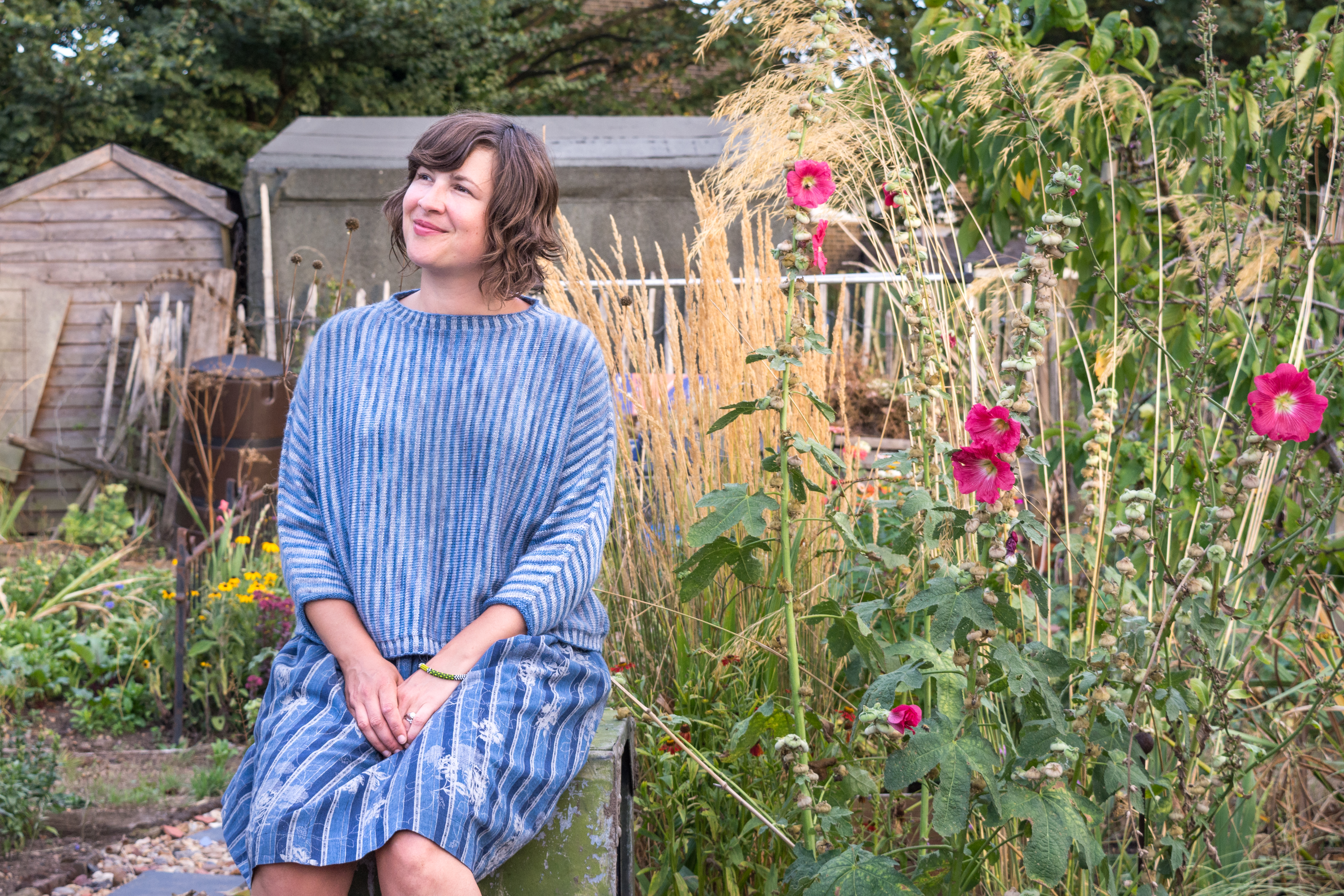Originally published in Pom Pom Quarterly, Issue 28, Spring 2019
When we knit, we are using plants indirectly and directly. It can sometimes get confusing which is which. Even the most carnivorous among us ingests some plant-based nutrition and that will be part of the energy that fuels our stitches. Certainly the chocolate and wine that enhance many a night of knitting come primarily from plants (thanks to human interference honed through the ages). Knitting needles or crochet hooks made of bamboo or birch often come directly from the plant. There’s careful selection before drying, shaping and sanding. Yet, needles and hooks can still be called bamboo and birch if they are formed from composites, meaning that particles left over from the cutting and sanding of larger pieces are bonded using adhesives. It’s still a direct process – you take the shavings directly from the raw material, mix them with glue, press real hard and then start the shaping and sanding process from the ‘new’ material.
When bamboo and birch are used to make yarn, they have to go through a more indirect process. Manufactured cellulose fibres come from the bark, wood and leaves of plants, be they grasses, shrubs, seaweed, or trees. These fibres might be familiar to you under names such as bamboo, rose, eucalyptus, viscose, rayon, modal, acetate, lyocell, Tencel, and seacell. They are what are known as semi-synthetics, meaning that their origin is more recently based in plants than in the petro-chemicals from which full synthetics are made. Crude oil was once also plants and animals, just a reeeeeeeeaally long time ago, so it’s possible to think of acrylic yarn as spun from dinosaurs*, in the same way that viscose comes from bamboo – it’s not a direct process.
For plant-based protein fibres from sources such as soya bean, corn, and peanut, it is the proteins that require extraction and spinning (in the same way that milk alternatives can be produced). For manufactured cellulose (also called regenerated cellulosic) fibres, it is the cellulose that is isolated for use. To put both processes crudely, to get semi-synthetic fibres/thread/ yarn from plant sources such as bamboo and birch, the plant bits are pulped and then melted down using multiple intense chemicals. Certain parts of the goop are isolated to be extruded, stretched out, and spun into fibres. A lot of water is involved. If this process can happen in a closed-loop system, where water and waste are carefully managed with less noxious chemicals, then problems are mitigated. In the rapidly changing array of these types of fibres, there is constant improvement.
The thing is, manufactured cellulose certainly is plant-based, but much more tenuously so than we might imagine. Many people might think that bamboo goes through a process from plant to fibre that echoes that of traditionally processed tough-cookies such as flax, hemp or nettle. Though traditional processes vary and are not without their own issues, put simply, the plant is harvested, whacked about to start breaking things down, then left to rot in water (this is called retting, and is now often sped up by the addition of chemicals), so only the stringiest, least degradable bits remain. These are whacked about a bit more to further soften them and then combed before being spun. No melting into goop and reforming. You can’t get thread from bamboo (or birch) like this, no way, no how. To me, the easiest distinction between traditional and semi-synthetic processes is to think about the former as being able to take place in living rooms or small farms (but let’s not be romantic and ignore the dust, hardships and danger of any form of textile production, or forget that it is the origin of the problematic Industrial Revolution, as well as having links to slavery, past and present). The semi-synthetics, on the other hand, have their origins in labs and require factories to carry out the processes.
To further complicate matters, our ‘living-room’ plant fibres, cotton, flax, hemp and nettle, like almost any other plants, can be used as bases for semi-synthetics. Alternatively, scientifically introduced enzymes can be called into action to speed up the process of softening them for our delicate contemporary taste. Also, on an industrial scale, the raw fibres can be altered through a process called cottonising. The vast majority of machinery in the textile industry has been built around processing cotton or wool, whose staple lengths range from 10cm (for cotton) to around 30cm (for wool). These machines can’t deal with bast fibres (the general name for fibres that come from stems, such as linen, hemp and nettle) that can clock in at 2m. By mechanically breaking down the length and width of flax, nettle and hemp staples, they can be spun alongside cotton and wool. A combination of these industrialised nature-modifiers appear to be behind the sudden boom of tricot fabrics (the tiny-scale knits used especially for T-shirts and socks), containing blends of hemp, nettle and/or linen with cotton. It’s also how a lot of yarn blends come into existence for us crafty folk. We should expect these factory fibres to behave differently from traditionally processed and spun hemp, nettle and linen, because they have been developed to have different characteristics. The drape and strength will certainly be different with these shortened fibres. This is why you can break many of the new linen blends by hand, rather than needing scissors, which the more traditional stuff does. Even in the face of these new processes, the number of plants we rely on for fibres has dropped dramatically over the past 200 years, through declining biodiversity, loss of knowledge, and market forces.
Throughout human history, we have nurtured our understanding of the plants we use, through selective gathering, breeding and, more recently, the sped-up version: genetic engineering. The resulting materials can be as raw as a hand-turned crochet hook, or as processed as the evolving semi-synthetics that take the place of fossil-based synthetics. So much remains to be learnt from plants, especially with a whole other dimension opening up in the field of plant neurobiology.
Plant neurobiology is a branch of science using evidence- based research to demonstrate how plants learn and have memory. It has already been established that plants do have cognitive abilities, and these new studies are sending tendrils out to explore how far these senses extend. There are convincing results that show exchange of knowledge and resources within interspecies communities through underground root networks, much like a botanical Ravelry. The discourse around this field raises ethical and philosophical questions, echoing semantic, identity, and classification debates happening elsewhere in the human world. To a large extent, the contention lies in what these senses should be called, and what we understand that to mean, based on existing cultural norms. You see, plant intelligence takes the pecking order that has always put humans on top and literally turns it on its head, because it is the plants’ root system that is most akin to our brain- centred neural networks.
There are many ways to learn and many different sorts of intelligence in humans, and the same is true with other fauna. Recognising the same possibilities in flora shakes things up. At the crux of evolutionary differences seems to be that the type of neurology anchored in brains, as we currently think of them, benefits self-contained movers and shakers such as humans, but wouldn’t suit relatively sedentary yet segmentable plants. Plants use different cognitive systems that we brain-centric beings haven’t been savvy enough to identify or value until now. Alongside the burgeoning of artificial intelligence, we are provided with prescient reasons to scrutinise alternative complex networks and their implications.
Anthropomorphism is inevitable, however green matter definitely thinks differently from grey matter, while artificial intelligence provides yet another angle. Human reasoning enjoys picking sides, so one becomes good and the other bad. We label things. We are storytellers and listeners. This is a key part of how we make sense of the world and are moved to support what we believe. I notice this happening a lot in our world of fibres. While filled with so much warmth, care and knowledge, the strong feelings, doses of snobbery, careful positioning and greenwashing can make it increasingly hard to dig up the bigger picture of fibres – and how we process them affects our future in terms of sustainability. While my own senses prefer the more traditionally processed fibres, both animal and vegetable, I am aware that this is based largely on what I can grasp, with my hands and mind. I find it easier to comprehend and judge whether and where they could be made more sustainable. When it comes to the newer ones, I must rely on what I am told without the benefit of generations of tacit knowledge.
Biodiversity would be a great thing to focus on as the artificial elements (synthetic fibres, genetic engineering, and machinery) we have introduced expand. It’s important to be conscious of whether we are making more fibres, of any description, because the growing human population needs protecting from the elements, or simply because we want more variety in our wardrobes. A lot of the emphasis on speed and economy of production, even environmental impact, is in line with desired consumption, not protection of the botanical world, which we now know has an intelligence all of its own. We need to ask how our desire for fibres affects the planet as a whole – humanity and plant kingdom alike.
*Actually crude oil is formed from marine life older than dinosaurs, but it’s more fun to think of dino-yarn.
Further reading
The Intelligent Plant newyorker.com/magazine/2013/12/23/the- intelligent-plant
Pavlov’s Plants: New Study Shows Plants Can Learn From Experience theconversation.com/pavlovs-plants-new-study- shows-plants-can-learn-from-experience-69794
Technology Could Allow Hemp And Flax To Break Cotton’s Global Hold On Textiles theguardian.com/sustainable-business/hemp-flax- bast-cotton-crailar
Preparation of Enzymatically Modified Flax Fiber for Producing of Rotor-Spun Yarn for Apparel fibtex.lodz.pl/55_08_22.pdf
Textile Qualities of Regenerated Cellulose Fibers from Cotton Waste Pulp journals.sagepub.com/doi/full /10.1177/0040517517 723021
Fibers & Fiber Plants faculty.ucr.edu/~legneref/botany/fibers.htm
A Brief History of Regenerated Cellulosic Fibres nonwoven.co.uk/2012/09/a-brief-history-of- regenerated.html
Eucalyptus fibre by any other name oecotextiles.wordpress.com/tag/regenerated-cellulose/
Producing Forest Products From Birch Trees nrcan.gc.ca/simply-science/20327






















